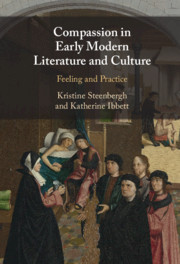Book contents
- Compassion in Early Modern Literature and Culture
- Compassion in Early Modern Literature and Culture
- Copyright page
- Contents
- Acknowledgements
- Contributors
- Introduction
- Part I Theorising
- Part II Consoling
- Part III Exhorting
- Part IV Performing
- Part V Responding
- Part VI Giving
- Part VII Racialising
- Part VIII Contemporary Compassions
- Index
Introduction
Published online by Cambridge University Press: 23 April 2021
- Compassion in Early Modern Literature and Culture
- Compassion in Early Modern Literature and Culture
- Copyright page
- Contents
- Acknowledgements
- Contributors
- Introduction
- Part I Theorising
- Part II Consoling
- Part III Exhorting
- Part IV Performing
- Part V Responding
- Part VI Giving
- Part VII Racialising
- Part VIII Contemporary Compassions
- Index
Summary
In the early modern period, the feeling and practice of compassion were recalibrated in a pressure cooker of social, religious and political changes.The rich philosophical heritage of classical ideas about the role of pity in virtuous citizenship and prudent statesmanship and the embodied practices of late-medieval affective meditation on compassion with the suffering of Christ jostled against new contexts of civil war, colonisation and capitalism. Notions of neighbourliness, charity and compassion became elastic as communities changed shape. Much of today’s critical impatience with compassion is predicated on its failure to follow through on its rhetoric, its incapacity to practice as it preaches. Yet early modern compassion was not merely an erudite textual tradition: it was also a set of practices that took on differing importance in different social and religious groups. These practices were impacted by and in turn shaped textual representations of compassion. The chapters in this volume analyse a broad range of sources to access the interplay between texts and practice in the early modern period.
Keywords
- Type
- Chapter
- Information
- Compassion in Early Modern Literature and CultureFeeling and Practice, pp. 1 - 22Publisher: Cambridge University PressPrint publication year: 2021



